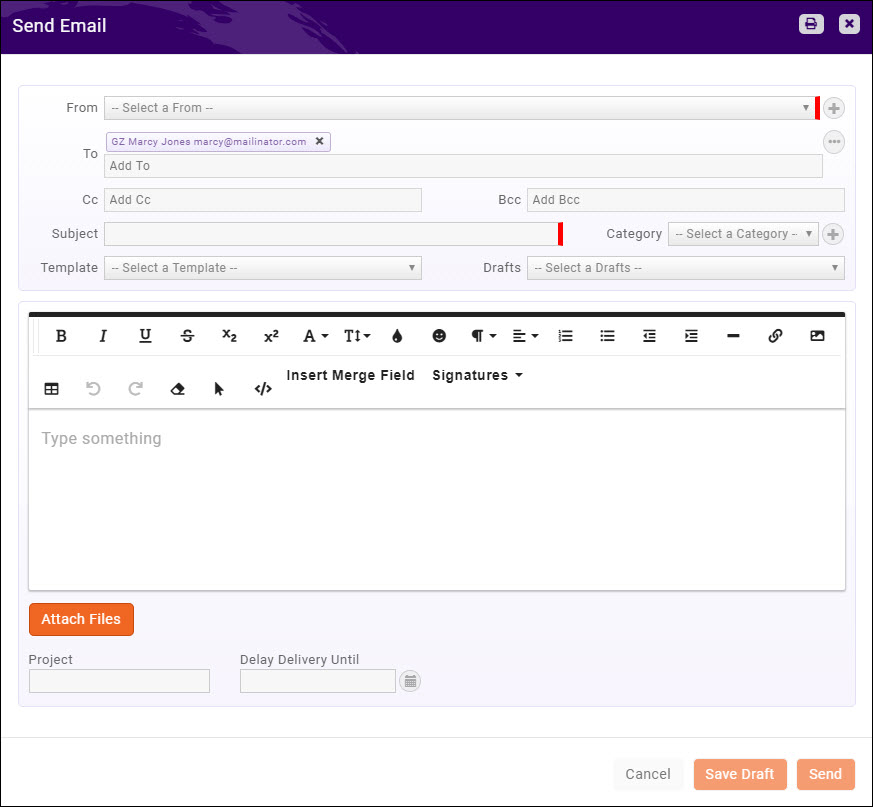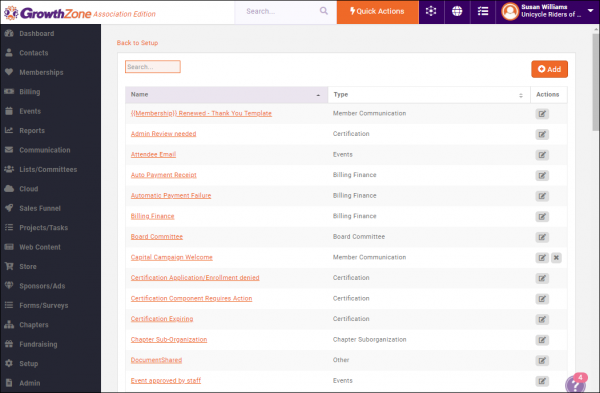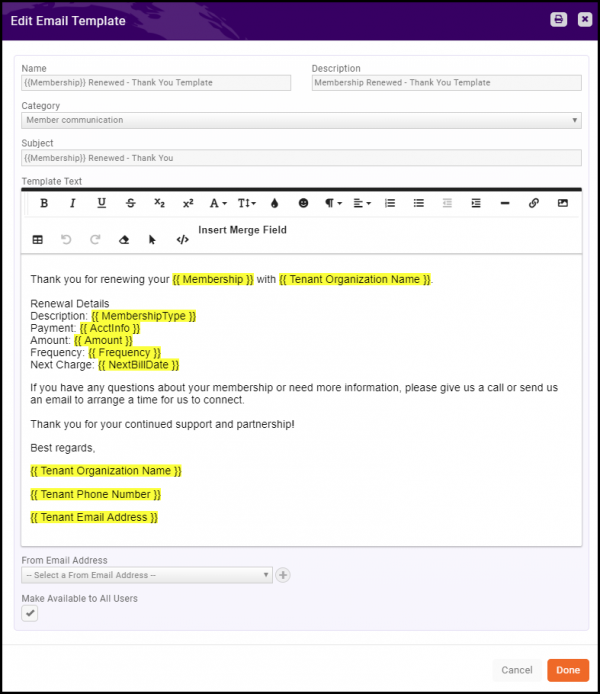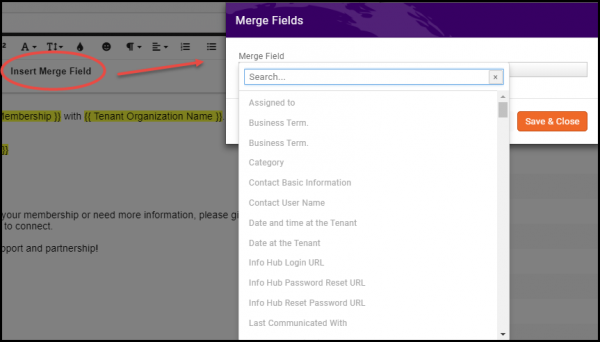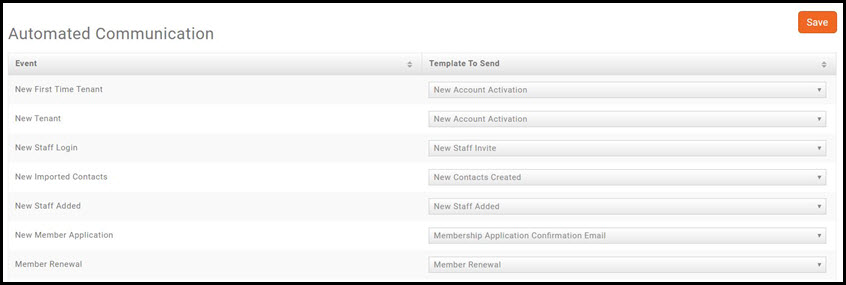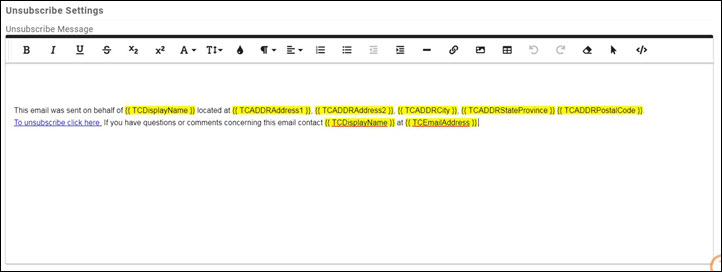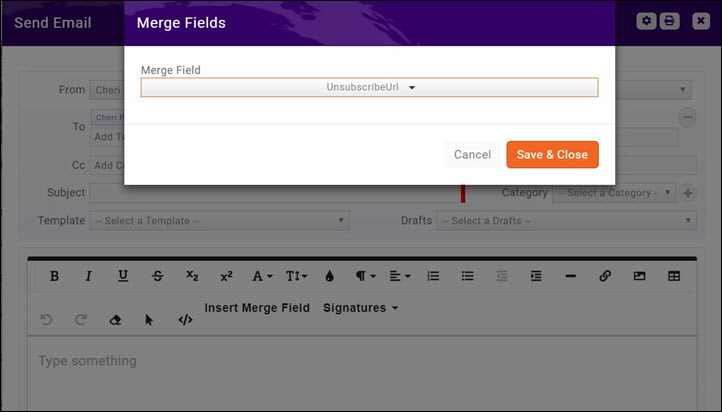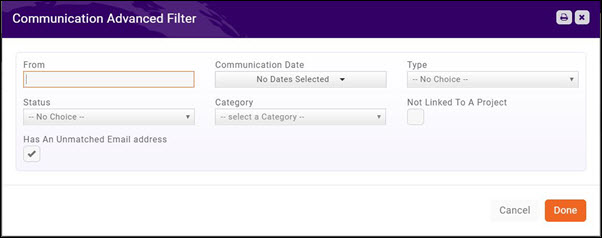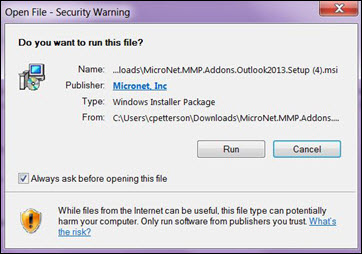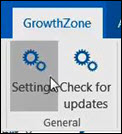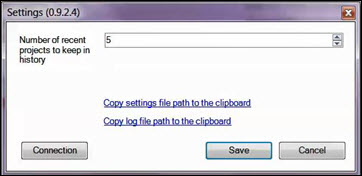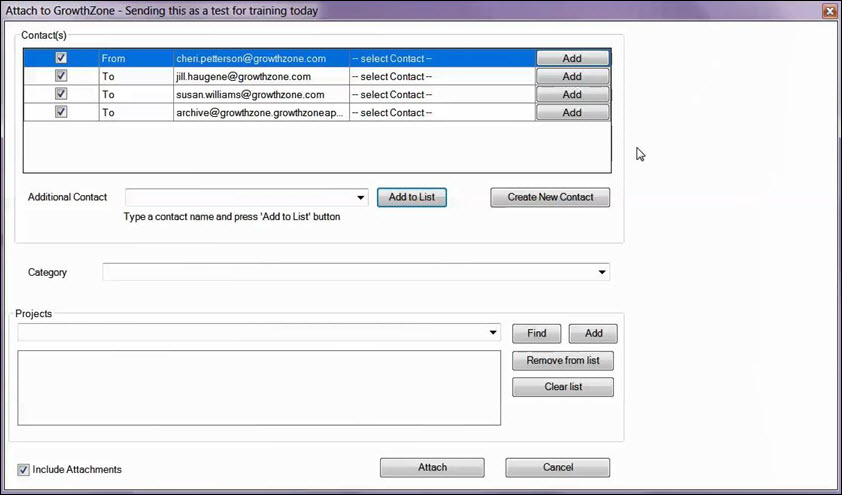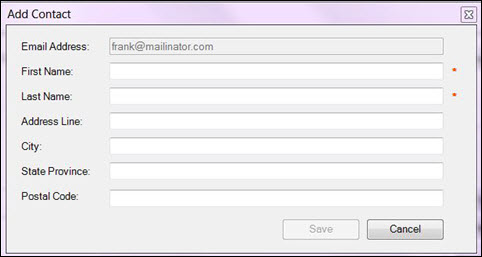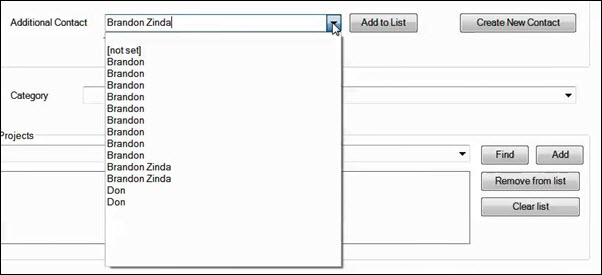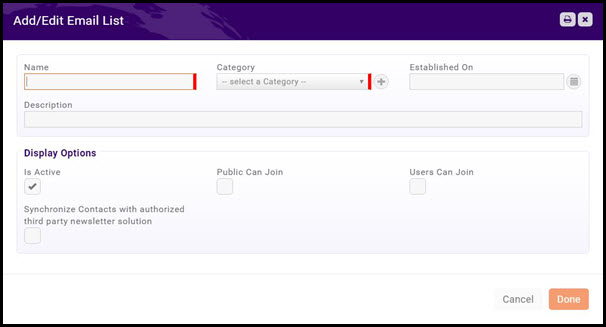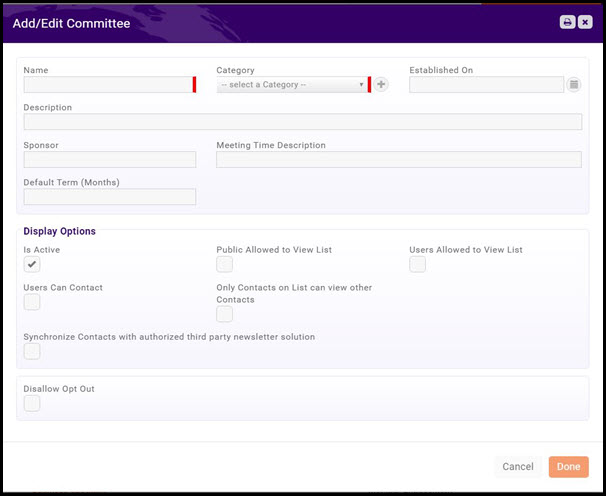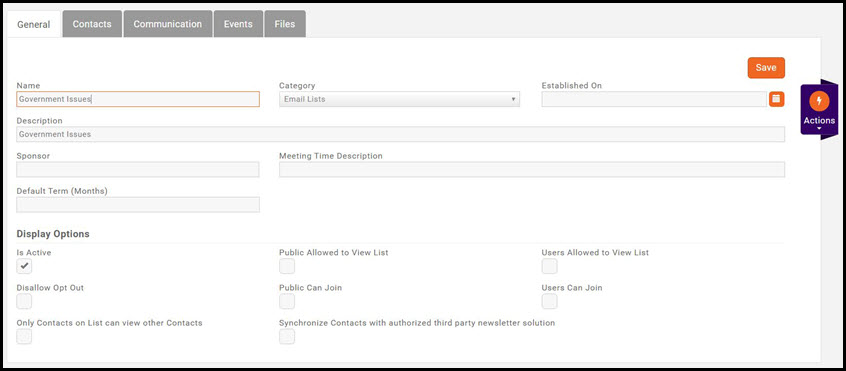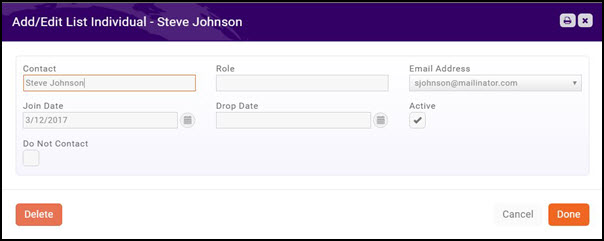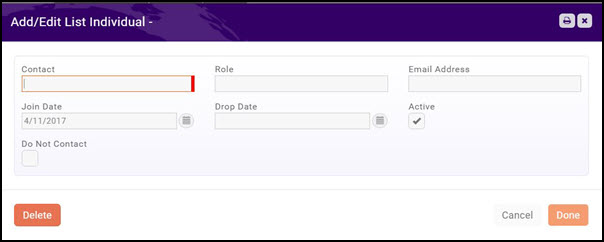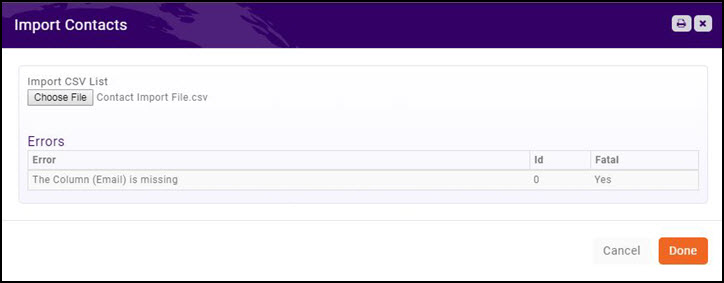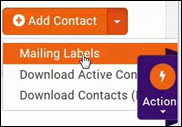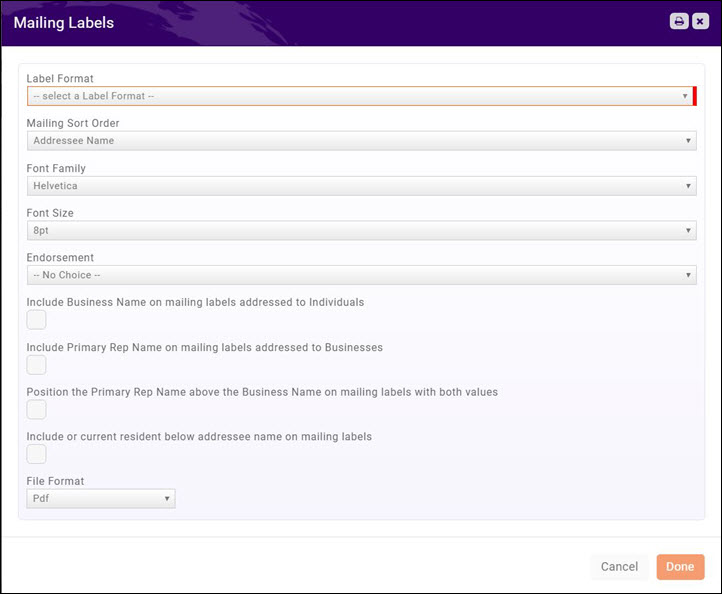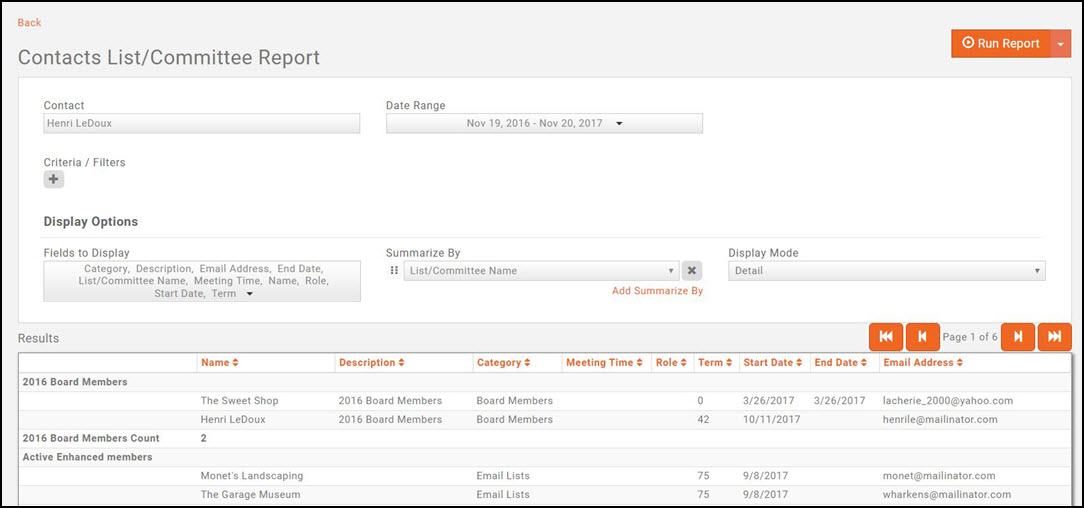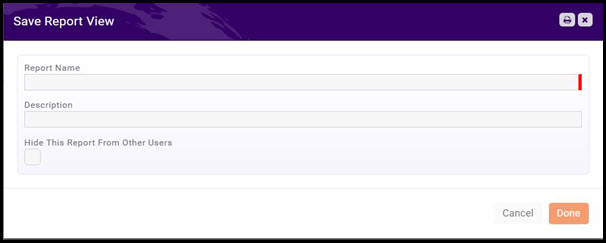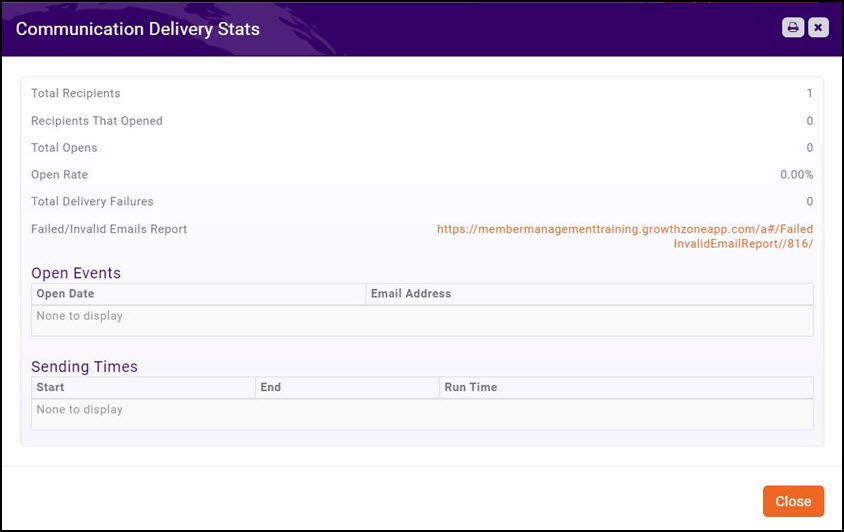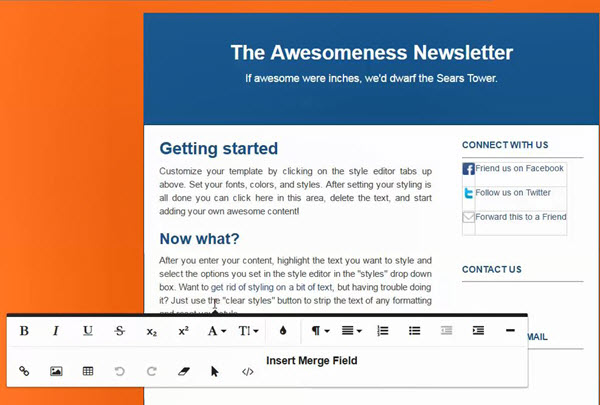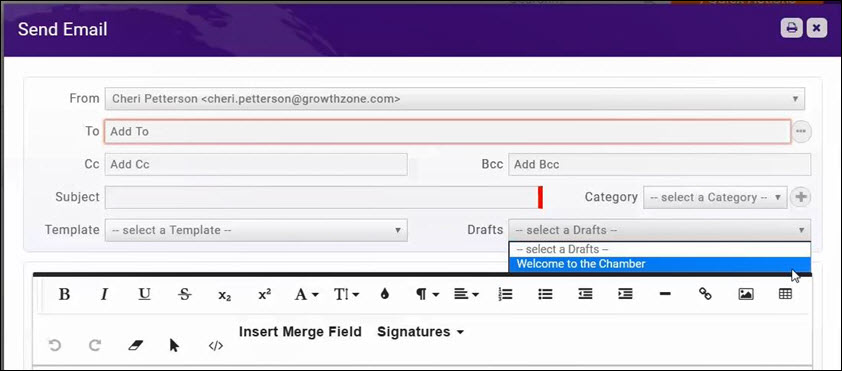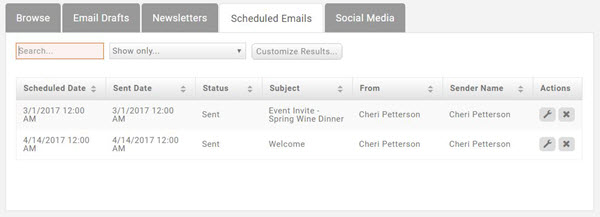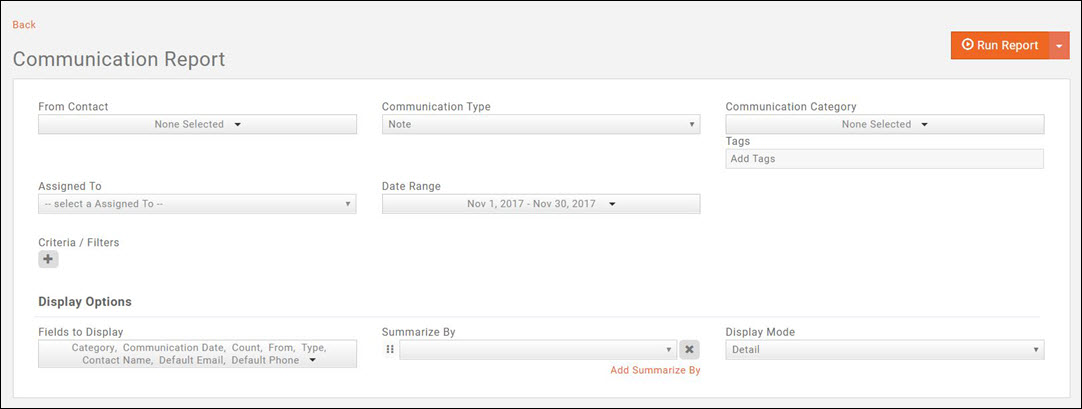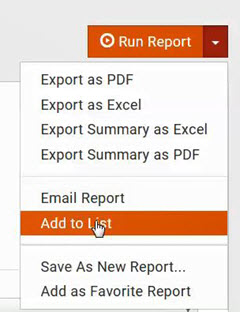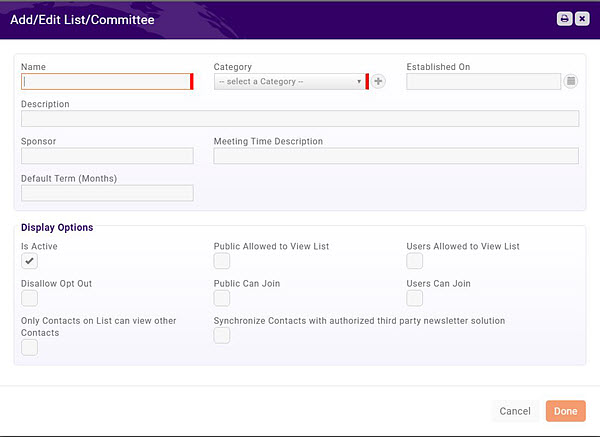Difference between revisions of "Communications Basics"
Cpetterson (talk | contribs) |
Cpetterson (talk | contribs) |
||
| Line 52: | Line 52: | ||
The message will be recorded in the Contact's Communication Tab as well as the Communication Module | The message will be recorded in the Contact's Communication Tab as well as the Communication Module | ||
===Sending an Attachment=== | ===Sending an Attachment=== | ||
| − | + | ||
| + | It is best practice to include links to documents, rather than attach files. Attachments may cause emails to be blocked, and there may be maximum file sizes allowed by some email providers preventing your attachments from reaching the final destination. Your GrowthZone software includes a Cloud, to which you can easily upload documents and create sharing links to include in your email. See '''[[Cloud#Working_with_Documents_in_the_Cloud|Working with Documents in the Cloud]]''' for further information. | ||
==Sending an Email to Multiple Recipients== | ==Sending an Email to Multiple Recipients== | ||
Revision as of 00:28, 4 December 2018
Contents
- 1 Create your Signature
- 2 Configure Communication Categories
- 3 Sending an Email
- 4 Sending an Email to Multiple Recipients
- 5 Create and Manage Email Templates
- 6 Configure Automated Messaging
- 7 Email Settings
- 8 Using the Outlook Add-on
- 9 Working with Lists/Committees
- 10 Communications Module
- 11 Communication Reporting
- 12 Communications FAQs
Create your Signature
Creating your signature will save time when sending email correspondence. You can design your signature with both text & graphics, and easily select it when sending email correspondence.
- Click Setup in the navigation panel
- In the Communications section, click Signatures
- Click the Add Button.
- Provide a Name for the signature. You can create multiple signatures, so you will wish to provide a name that allows you to differentiate between signatures.
- In the Signature HTML text box you can customize your signature by adding your organization name, an image, a link, etc. Common word processing icons make it easy to format your signature as you desire.
- When completed, click Done.
Configure Communication Categories
Communication Categories provide a way for you to organize and filter email communications. Reports such as the Communication Report can be filtered by category to allow you to get a better understanding of the communications that are being sent.
- Click Setup in the navigation panel
- In the Communications section, click Communications Categories. A list of the current categories in the database will be displayed.
- Click the Add button to add a new category. The Add/Edit Communications Category dialog box will be displayed.
- Enter a Name for the category. This name will be displayed when you are selecting communication categories within the software so it should be descriptive and reflect the purpose of this category.
- N/A at this time
- Click Done to save the new category.
Sending an Email
Clicking directly on an email address will open a new email message in your email program (Outlook). This is fine, but the communication will NOT be recorded in the Communication tab of the receiver.
To send a message that WILL be recorded, initiate it through any of the built-in Send Email functions:
- In the Send Email window that appears, fill in the relevant and appropriate fields:
-
- From Required. This is a drop-down containing staff users
- To Required. If you initiate the email from within a Contact Record, this will already be populated. You can add recipients by clicking in the Add To field and typing the name you want. The system will search on-the-fly and you can select the user when it appears in the list
- Add Cc Begin typing in this field to select the user you want to Cc on the email.
- Add Bcc Begin typing in this field to select the user you want to Cc on the email.
- Subject Required.
- Category Select a Category if desired. Refer to Communication Categories for details.
- Template Select a Template if desired. Refer to Create and Manage Email Templates for details.
- Drafts If you are continuing a draft, you can select it here
-
- Enter the text of the message. You have editing capabilities and are able to insert database fields if desired.
- Click Attach Files if necessary. See Sending an Attachment for best practice information.
- Enter the Project name in the Project field if appropriate (requires the Projects/Tasks module.) This will record the email in the Communication Tab of the selected Project.
- Enter a Date/Time in the Delay Delivery Until field if appropriate. This allows you to compose an email at your convenience but not have it sent until the day you select.
- If you need to finish the message later, click Save Draft
- If you are ready to send, click Send
The message will be recorded in the Contact's Communication Tab as well as the Communication Module
Sending an Attachment
It is best practice to include links to documents, rather than attach files. Attachments may cause emails to be blocked, and there may be maximum file sizes allowed by some email providers preventing your attachments from reaching the final destination. Your GrowthZone software includes a Cloud, to which you can easily upload documents and create sharing links to include in your email. See Working with Documents in the Cloud for further information.
Sending an Email to Multiple Recipients
You initiate an email to multiple recipients exactly the same way as for a single recipient. The only difference is how you select the recipients.
Manually Entering Multiple Recipients
- In the Add To field of the email message, type the name of the first recipient. The system will type ahead. Select the recipient when the name appears.
- Repeat until all recipients are added.
Selecting Multiple Recipients Based on Criteria
- Click on the Ellipse icon to the right of the Add To field,

- From the Address Book that appears, select the group or groups you want to send to
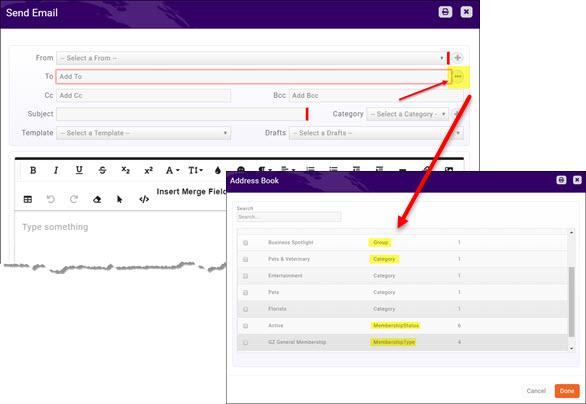
- Different types of groups are present:
- Group--a List or Committee you created
- Category--based on Categories a contact is associated with
- Membership Status--based on the Membership Status of the contact
- Membership Type--based on the Membership Typeof the contact
- You can scroll through the list or use the Search field at the top
- Click Done
Refer to Sending An Email for additional details.
Create and Manage Email Templates
Email templates provide an easy way to respond to standard email tasks. For example, you may wish to send a thank you email to all those who have attended an event. You can create (or customize a default) template that can be used consistently for all of your events. This will allow you to efficiently send emails, and increase productivity. Email templates may also include database fields.
There are a variety of default email templates populated in the database that you may us to meet your business needs. You may view the existing templates, edit copies of the existing templates, or create your own. To do any of these actions,
- Click Setup in the navigation panel
- In the Communications section, click Email Templates. A list of the default email templates will be displayed.
View a Default Email Template
From the list of templates, (Setup > Communication > Email Templates),
- Click the name of the email template you wish to view or modify. The Edit Email Template dialog box will open. The following fields are displayed for your review:
- Name - The name of the template is displayed for selection when you are sending emails. Additionally, the name of an email may be used for filtering and reporting.
- Description - This field allows you to provide more details about this template. Visible internally only.
- Category-The category field allows you to associate this template to specific email categories, and may also be used for filtering. Internal only.
- Subject-The subject is the subject line of the email.
- Template Text-The template text is the body of the email.
- Make available to all users- when viewing a default template this checked box will indicate if the template is available to all users.
- Click the Done button when finished viewing
Edit a Default Email Template
From the list of templates, (Setup > Communication > Email Templates)
- Click the Edit icon (
 ) to the far right of the template name
) to the far right of the template name
- NOTE: The system is actually making a copy for you to edit. Original templates themselves cannot be edited or deleted
- Make changes in the Edit Email Template window that appears. See View a Default Email Template above for description of available fields.
- Name - If you do not change the name, the system will add the word "Copy" to the end of it.
- Description
- Category
- Subject Database fields (indicated by {{ }} ) cannot be added by the user to the subject line. If the subject line of the template you are editing contains a database field that you don't want, simply delete it (you cannot edit it).
- Template Text In the body of the email database fields are in double brackets and also highlighted in yellow. The field contents will not be highlighted in the sent message. Also, only make cosmetic or location changes to these fields (do not edit the names). See below for how to add fields to the template.
- From Email Address-select the staff address from the dropdown that will be used if the email is sent automatically
- Make available to all users- check this box if you want this template to be available. If unchecked the template will only be available to the person who created it
- Click Done
Adding Database Fields
- Put your cursor where you want the data base field
- Click on Insert Merge Field in the editing bar
- Scroll through the list of available fields (or use the Search feature at the top of the list)
- Not every field in the database is available to merge
- "Tenant" refers to your organization
- Click on the field you want to enter
- Click the Save & Close button
Add a New Email Template
From the list of templates, (Setup > Communication > Email Templates)
- Click the Add button in the top right corner
- Configure the available fields: See View a Default Email Template above for description of available fields.
- Name
- Description
- Category
- Subject
- Template Text
- Customize font and paragraphs using the standard word-processing icons such as bolding, italicizing, underlining, etc.
- Insert hyper-links and images.
- Select the Insert Merge Fields
- Select a Signature
- From Email Address
- Make Available to Other Users
- Click Done.
Configure Automated Messaging
Automatic messages may be configured to be sent in response to certain actions. For Example, an automated message may be sent to a new member when they have completed the Member Application Form, or, an automatic thank you message may be sent when someone registers for the event. Your database is pre-configured with automatic messages, which you may use "as-is" or customize to meet your needs.
- Click Setup in the navigation panel
- In the Communications section, click Automated Messaging. A list of the available options for automated messages is displayed. See table below for further details.
- You may change the default message sent for each of the available options.
- If changes are made, click the Save button to save your changes.
Email Settings
Configure your Unsubscribe Message
- Select Setup in the Navigation Panel
- Click Email Settings in the Communications section.
- A default unsubscribe message is included in your database. You can customize this as needed.
- Click Done.
When the user clicks the link, they will be presented with the Email Subscriptions screen. See What happens when a group email recipient opts out for further information.
If you wish to add the unsubscribe message to individual emails or emails sent to multiple members, include the Unsubscribe URL merge field in your signature or in text at the bottom of an email.
What happens when a group email recipient opts out
The unsubscribe message you have configured in your settings (See Configure your Unsubscribe Message) is appended to all emails sent to groups.
If the recipient wishes to unsubscribe, by clicking the link they are presented with the dialog box shown below:
The recipient can make the following choices:
- Continue Receiving Emails from {Your Organization Name}: Selecting this option does Not unsubscribe them from the group email list.
- Unsubscribe me from {Group Name}: Selecting this option will mark the recipient as DO NOT CONTACT within the group. It will NOT remove the recipient from the group. An email will be sent to those staff members who have subscribed to the
- Do not email me at this address: If this option is selected, the email used for sending the group email will be marked as do not contact. This will unsubscribe the member from ALL group communication. The recipient is NOT removed from the group.
- Update my preferences: When this option is selected, the recipient will see a list of the groups that they are currently subscribed to.
- The recipient may deselect the check-boxes for the groups they no longer wish to be subscribed to. The recipient will be marked as Do Not Contact within the group, but will NOT be removed from the group.
After making choice, click Submit. A confirmation of changes will be displayed.
Logging Messages sent via Outlook (or other email service)
In the Email Settings you will find and Archive Email Address. In order for your database to track emails that you have sent from Outlook (or other email service such as GMail), you will want to include this email address in the BCC line of the email. A copy of the email will then be sent to the archive address for evaluation. If the system can associate the contact to whom you sent the email to a contact in the database, your outlook email will be displayed on the communications tabs.
- Select Setup in the Navigation Panel
- Click Email Settings in the Communications section.
Viewing Un-Matched Outlook (or other email service) Emails
As described above, if the archive email address is included in the BCC line of emails sent via Outlook, a copy of the email will be sent to the archive address. If the database is able to associate the email to a contact in your system it will do so. Emails that could not be matched may be viewed under the Communications module:
- Click Communications in the Navigation Panel.
- On the Browse tab - click the Customize Results button.
- Click the Has An Unmatched Email address checkbox.
- Click Done.
The list of emails will now filtered to those with an unmatched emails.
Setting up Sender Policy Framework (SPF) Records
An SPF record is a type of Domain Name Service (DNS) record that identifies which mail servers are permitted to send email on behalf of your domain. The purpose of the SPF record is to prevent spammers from sending messages with forged From addresses at your domain.
Domain Name Servers (DNS) are the internet's equivalent of a phone book. They maintain a directory of domain names and translate them to the Internet Protocol (IP) addresses. By default, the system will send emails on behalf of the selected "from" address. In order for GrowthZone to send directly on your behalf without the risk of "sent on behalf" messages in the from line, the following needs to be setup in their DNS.
Below are the steps to set-up the SPF record. There is action required within the DNS itself. The second action is within GrowthZone setup. Upon initial setup of your database, GrowthZone will assist you.
Step 1
For each of the record names below, replace your domain.com with the the domain that is after the @ sign in your email.
| Record Name | Type | Data |
| _dmarc.yourdomain.com | TXT | v=DMARC1; p=none; sp=none |
| _dmarc.yourdomain.com | CNAME | clientemailtracking1.growthzoneapp.com |
| mmptrack2.yourdomain.com | CNAME | clientemailtracking2.growthzoneapp.com |
| mmpspf.yourdomain.com | CNAME | clientemailsubspf.growthzoneapp.com |
| s1._domainkey.yourdomain.com | CNAME | clientemaildkim1.growthzoneapp.com |
| s2._domainkey.yourdomain.com | CNAME | E clientemaildkim2.growthzoneapp.com |
| s3._domainkey.yourdomain.com | CNAME | clientemaildkim3.growthzoneapp.com |
| s4._domainkey.yourdomain.com | CNAME | clientemaildkim4.growthzoneapp.com |
| @ | TXT | v=spf1 include:clientemailspf.growthzoneapp.com ~all |
Step 2
After the DNS records have been updated, go to Setup>Communication>Email Settings. Ensure that both Use System Email Settings and Is DNS Setup are checked.
Using the Outlook Add-on
The Outlook Add-on provides the ability to attach e-mails, sent via Outlook, to a contact's general communication tab and/or to a project.
Installing the Outlook Add-on
Download the Outlook Add-On to start tagging incoming or sent emails:
- Click Setup.
- Click Outlook Add-on in the Software Add-Ons section. NOTE: The Outlook Add-on must be installed on all pc's, laptops, etc. that will require its use.
- Run the Windows Installer Package as directed.
- Once you have completed the installation of the Outlook Add-on, open your Outlook program. In the menu bar, you will be able to see a GrowthZone option.
- Click the GrowthZone link.
- Click Settings.
- Click Connection.
- Enter or confirm your GrowthZone user name and password.
- Click Connect.
- Click Save.
Attaching emails to contacts/projects
The this functionality will allow you to attach the communication to the original recipient(s) and sender. Additionally, you can select contacts from your database (or create new contacts) who may not have been initial recipient(s)/sender of the email. You can also attach the communication to your existing projects, or create a new project to which the communication can be associated.
- In Outlook, open the email that you wish to attach to a contact/project.
- Click the Attach icon located on far right in the menu bar.
- In the Contact(s) section, a list of the to/from contacts of the email will be listed. To attach the initial recipient(s)/sender of the email:
- By default all contacts are selected, which would result in the communication being attached to all. You can deselect any of the to/from contacts if you do not wish to attach to their communication log.
- If the email address is associated to a Contact in your database, the name of the contact will be displayed in the last column.
- In the example below, the system was able to match the first email to a contact, but not to the others.
-
- If there are multiple contacts associated to the same email address, --select Contact-- will be displayed. Double-click on --select Contact-- to select the appropriate contact name. In the example below, multiple contacts were associated to the email address.
-
- If there are no matching contacts in the database, no selections will be available when clicking --select Contact--. If you wish to add the contact to your database, click the Add button adjacent to the appropriate row. The Add Contact dialog box will be displayed. Enter contact information, and click Save.
- Attaching the communication to other contacts (not the original recipient(s)/sender of the email: Begin typing the name of the contact in the Additional Contacts text box. A list of contacts matching your text will be displayed. Select the desired contact and click the Add to List button.
- If no match is found in your database to the information you have typed in the Additional Contacts text box, you may add a new contact to the database by clicking the Create New Contact button.
- Select a communication Category. This is optional, but allows you to classify your communications for ease in filtering and reporting.
- Attaching the communication to a Project: If you are using the GrowthZone Projects module, you can also attach communications to projects. Begin typing the name of the project in the Projects text box. A list of projects matching your text will display. Select the desired project. If the project to which you wish to attach the communication does not exist, you can add a new project by clicking the Add button.
- Click Attach.
Working with Lists/Committees
Sending communication via email and letters may be simplified by creating lists/committees. Additionally, you can allow your members to automatically join the lists/committees that they wish to participate in.
Add a New Email List
- Click Lists/Committees in the Navigation Panel. A listing of all lists/committees configured in your database will display. On installation of the software, common lists have been populated, such as Current Staff, Ambassadors, etc. You may use these lists as configured, or customize them to meet your needs.
- Click the Add Email List button.
- Configure the following on the Add/Edit Email List screen:
- Name - Enter a name for the new list. Use a name that well describes this list, as it will be displayed in the To line of your emails.
- Category - Select the category to which you want to associate this list. Categorizing will make it easier to filter and report on this list.
- Established On - If you wish to track when this group list was started, enter an established on date.
- Description - Provide a description of the list (Optional).
- Display Options:
- Is Active - Select this check-box to activate this list. If the list is not activated, it will not be displayed.
- Public Can Join - Select this check-box to allow the public to join this list. If selected, the list may be displayed on your web-site.
- Users Can Join - Select this option to allow your member users to join this list. If selected, the list may be displayed on your web-site.
- Synchronize Contacts with authorized third party newsletter solution - If you are using a third party solution, such as Constant Contact, select this option to synchronize this group to your solution.
- Click Done.
Add a New Committee
- Click Lists/Committees in the Navigation Panel. A listing of all lists/committees configured in your database will display. On installation of the software, common lists have been populated, such as Current Staff, Ambassadors, etc. You may use these lists as configured, or customize them to meet your needs.
- Click the drop-down arrow on the Add Email List button, and select Add Committee.
- Configure the following on the Add/Edit Committee screen:
- Name - Enter a name for the new list. Use a name that well describes this list, as it will be displayed in the To line of your emails.
- Category - Select the category to which you want to associate this list. Categorizing will make it easier to filter and report on this list.
- Established On - If you wish to track when this group list was started, enter an established on date.
- Description - Provide a description of the list (Optional).
- Sponsor - Enter the name of the committee sponsor (Optional).
- Meeting Time Description - Enter information about the meeting times for this committee.
- Default Term (Months) - Enter the default term length that members may sit on this committee (Optional).
- Display Options:
- Is Active - Select this check-box to activate this list. If the list is not activated, it will not be displayed.
- Public Allowed to View List - If this option is selected, you may include this list as a page on your web-site.
- Public Can Join - Select this check-box to allow the public to join this list. If selected, the list may be displayed on your web-site.
- Users Can Join - Select this option to allow your member users to join this list. If selected, the list may be displayed on your web-site.
- Users Can Contact - Select this option if you wish to allow all users to contact members of this committee.
- Only Contacts on List can view other Contacts - Select this option if you wish to limit who can view contacts on the list to only other contacts on the list.
- Synchronize Contacts with authorized third party newsletter solution - If you are using a third party solution, such as Constant Contact, select this option to synchronize this group to your solution.
- Disallow Opt Out - Select this option if you do not wish members on the list to be able to opt out from the list.
- Display Options:
- Click Done.
Managing Lists/Committees
- Click Lists/Committees in the Navigation Panel. A listing of all lists/committees configured in your database will display.
- Click the hyper-link for the list/committee you wish to work with. The List/Committee screen provides four tabs to manage the list/committee: General, Contacts, Communications, Events, and Files.
Update List/Committee General Settings
The General tab allows you to update the settings you configured when the list/committee was first created.
You can view and/or change the following settings on the General tab:
- Name - Enter a name for the new list. Use a name that well describes this list, as it will be displayed in the To line of your emails.
- Category - Select the category to which you want to associate this list. Categorizing will make it easier to filter and report on this list.
- Established On - If you wish to track when this group list was started, enter an established on date.
- Description - Provide a description of the list (Optional).
- Sponsor - Enter the name of the committee sponsor (Optional).
- Meeting Time Description - Enter information about the meeting times for this committee.
- Default Term (Months) - Enter the default term length that members may sit on this committee (Optional).
- Display Options:
- Is Active - Select this check-box to activate this list. If the list is not activated, it will not be displayed.
- Public Can Join - Select this check-box to allow the public to join this list. If selected, the list may be displayed on your web-site.
- Users Can Join - Select this option to allow your member users to join this list. If selected, the list may be displayed on your web-site.
- Users Can Contact - Select this option if you wish to allow all users to contact members of this committee.
- Only Contacts on List can view other Contacts - Select this option if you wish to limit who can view contacts on the list to only other contacts on the list.
- Synchronize Contacts with authorized third party newsletter solution - If you are using a third party solution, such as Constant Contact, select this option to synchronize this group to your solution. NOTE: If the group is set to allow opt-outs, the Synchronize Contacts with authorized third party newsletter solution option will be grayed out. Groups that are set to disallow opt out may not be synchronized to a third party solution.
- Disallow Opt Out - Select this option if you do not wish members on the list to be able to opt out from the list. See What happens when a group email recipient opts out for further information on opt-outs. NOTE: If the group is set to synchronize to a third party news letter, the disallow opt out option will be grayed out. Groups that are set to disallow opt out may not be synchronized to a third party solution.
Click the Save button if you have made changes.
View and/or Edit Contacts on a List/Committee
You may view and/or add contacts to a List/Committee on the Contacts tab.
- Click Lists/Committee in the Navigation Panel. A list of the lists/committees currently configured in your system will be displayed.
- Click the hyper-link for the list you want to view.
- Click the Contacts tab. A list of all of the contacts in the list/committee will be displayed.
- Click the pencil icon in the actions column to edit details of a contact.
- Update the desired fields:
- You may drop a contact from this list by entering a Drop Date.
- You may deactivate this contact from the list by deselecting the Active button. This will remove the contact from the list.
- You may keep the contact in the list, but prevent emails from being sent to the contact by clicking the Do Not Contact check-box.
- Click Done.
View Historical Contacts for a List/Committee
- Click the Customize Results button.
- Click the Include Historical Contacts check-box.
- Click Done. The contacts list will refresh and display historical information.
Add Individual Contact(s) to a List/Committee
- Click Lists/Committee in the Navigation Panel. A list of the lists/committees currently configured in your system will be displayed.
- Click the hyper-link for the list you want to view.
- Click the Contacts tab. A list of all of the contacts in the list/committee will be displayed.
- Click the Add Contact button.
- Configure the following fields:
- Name - Enter the name of the contact. If the contact exists in your database, as you type ahead contacts that match will be displayed.
- Role - This is an optional field where you can assign a role to this contact.
- Email Address - Select the contacts email address. If an address has not been configured you will need to go to the individual contact page to enter it.
- Join Date - The join date will default to the current date. You may change this if necessary.
- Active - Select this check-box.
- Do Not Contact - if the members wishes to be on the list/committee but does not want to be contacted, click this check-box.
- Click Done.
Add Contact(s) to List/Committee using a File
If you have an existing spreadsheet of individuals that you wish to add to your lists/committees, this can be easily imported.
- Click Lists/Committee in the Navigation Panel. A list of the lists/committees currently configured in your system will be displayed.
- Click the hyper-link for the list you want to view.
- Click the Contacts tab. A list of all of the contacts in the list/committee will be displayed.
- Click the arrow on the Add Contact button.
- Click Import Contacts (CSV).
- Click choose file and navigate to the desired file.
- Click the file.
- Click Open.
- NOTE: File format is displayed below. The file must include headers and email is required.
- If an error occurs in importing the file, the error will be displayed in the Import Contacts dialog box. Fix errors and re-import the file.
- If no errors occur, click Done. The contacts will be added to the list.
Create Mailing Labels for Lists/Committees
From the Lists/Committees Module you can create mailing labels from the Contacts tab.
- In the Lists/Committees module, click the hyper-link for the list/committee for which you want to create mailing labels.
- Click the Contacts tab.
- Click the down arrow on the Add Contacts button.
- Click Mailing Labels.
- Select the Label Format from the list. Standard Avery label formats are available.
- Select the Mailing Sort Order.
- Select the font you want to use from the Font Family list. Standard fonts are available.
- Select the font size you wish to use from the Font Size list.
- Select the Endorsement you wish to use. This allows you to define what you wish the postal service to do in the event mail is undeliverable, etc.
- Include Business Name on mailing labels addressed to Individuals - Select this check-box if you want to include the business name on the labels, when addressed to an individual.
- Include Primary Rep Name on mailing labels addressed to Businesses - Select this check-box if you want to include the Primary Rep name on the labels, when addressed to a business.
- Position the Primary Rep Name above the Business Name on mailing labels with both values - Select this to place the Primary Rep name above the business name.
- Include or current resident below addressee name on mailing labels - Select this option if you wish the labels to include "Or Current Resident".
- File Format - Select the file format you wish to use.
- Click Done to print your mailing label template.
Contacts List/Committee Report
The Contact List/Committee Report may be used to generate a report of all of your lists/committees and the individuals associated to those lists/committees. The report may be filtered by an individual contact if you wish to see all group membership for an individual and/or by a specified date range.
- Click Reports in the Navigation Panel
- Select Contact List/Committee Report.
- Select your search filtering criteria.
- Click Run Report.
You can perform the following actions with the report by clicking the down arrow on the Run Report button:
- Export as PDF
- Export as Excel.
- Export Summary as PDF
- Export Summary as Excel
- Email Report
- Add to List - This option will allow you to add the members to an existing list, or create a new list (by clicking the + button on the Add Contacts to List screen). This can help you in sending emails to this group as necessary.
- Save as New Report - If you want to use this report with the same filtering options in the future, you can save the report.
- Add as a Favorite Report - you may save the report as a favorite, then easily identify it when filtering reports in the Reports module.
Communications Module
Review All Communications
You may review and manage all communications in the Communications module. (Select Communications in the Navigation Panel). On the Communications module Browse tab, you will be able to review ALL communications. This list includes emails, notes and logged phone calls. You may easily search the list, or filter/customize the result using the options on the top of the screen.
View Email Delivery Statistics
The Communication Delivery Stats will help you understand the effectiveness of your communications. This will allow you to gauge the success by looking at open rates, and allows you to check to see whether an individual recipient received/opened the message. This allows you to see who did not receive the communication based on a delivery failure so that you can determine possible list/contact cleanup then redistribute.
You can view whether recipients have opened an email by clicking the ![]() Communication Delivery Stats icon.
Communication Delivery Stats icon.
The Communications Delivery Stats screen will display the number of recipients of an email, as well as the number of individuals who opened the email. You will be able to see which recipient opened the email in the Open Events section. Click on the Failed/Invalid Emails Report link to view a report of failed emails. See Failed/Invalid Email Report for further details.
Send Newsletters
On the Communications module Newsletters tab, you can be easily created and send newsletters. Default Newsletter templates have been setup in your system that may be used as designed or you may customize them to meet your needs. Refer to Create and Manage Email Templates to view the default templates.
You can send the newsletter to individual contacts and/or a list/committee by entering the contact name in the To box.
The content of the Newsletter can be edited, by clicking into the different sections of the letter and using the style editor functions to format text, add links, images and so on.
Click the Send Preview button to send the newsletter to yourself or others for review prior to sending the newsletter out.
View Email Drafts
When you have created and email and clicked Save Draft, you can view the drafts on the Email Drafts tab of the Communications module.
You can edit or delete the Email Draft on the Email Drafts tab. Additionally, but clicking the subject of an email, the Send Email screen will be displayed, and you can send the email.
Sending Your Draft Emails
If you wish to send a draft email, you can select it from the Drafts list on any Send Email screen.
NOTE: Once a draft email is sent, it is no longer listed on the Email Drafts page, nor will it be visible in the drafts drop-down list when sending emails. It is not a template.
View/Edit/Delete Scheduled Emails
On the Communications module Scheduled Emails tab, you can be view, edit and delete scheduled emails.
Click the Edit Email ![]() icon to view and edit the scheduled email.
Click the Delete
icon to view and edit the scheduled email.
Click the Delete ![]() icon to view and edit the scheduled email.
icon to view and edit the scheduled email.
Communication Reporting
Communication Report
The Communication Report allows you to generate a list of all communications (regardless of type). The report may be filtered to a specific From Contact, specific type of communication, communication category, assigned to, date range, category, or your own custom filters.
- Click Reports in the Navigation Panel
- Select Communication Report.
- Select your search filtering criteria.
- Optional - Enter a Search/Filter query. For example, if you want to filter the report results to just a specific business category you would select Business Category as filtering criteria.
- Select Display Options. They system is setup with default fields to display in your report. You may add or remove fields by clicking on the Fields to Display drop-down arrow.
- Select Summarize by criteria. This optional field allows you to select how you wish report results grouped. For example, you may choose to group results by type of communication.
- Click Run Report.
You can perform the following actions with the report by clicking the down arrow on the Run Report button:
- Export as PDF
- Export as Excel.
- Export Summary as PDF
- Export Summary as Excel
- Email Report
- Add to List - This option will allow you to add the members to an existing list, or create a new list (by clicking the + button on the Add Contacts to list screen). This can help you in sending emails to this group as necessary.
- Save as New Report - If you want to use this report with the same filtering options in the future, you can save the report.
- Add as a Favorite Report - you may save the report as a favorite, then easily identify it when filtering reports in the Reports module.
Failed/Invalid Email Report
The Failed/Invalid Email Report generates a list of all emails that have failed in a specific date range. This report may be useful in identifying emails that have not successfully reached the recipient (and the reason), as well as provide information for cleaning up your emails within the database.
- Click Reports in the Navigation Panel
- Select Failed/Invalid Email Report.
- Select your search filtering criteria.
- Optional - Enter a Search/Filter query. For example, if you wish to view failed emails that contained the word invoice in the subject line, you would select Communication Subject Contains Invoice.
- Select Display Options. They system is setup with default fields to display in your report. You may add or remove fields by clicking on the Fields to Display drop-down arrow.
- Select Summarize by criteria. This optional field allows you to select how you wish report results grouped. For example, you may choose to group results by communication subject.
- Click Run Report.
From the report, you can click on the invalid email address to navigate to the location in the software where the email address is used. This allow you to easily update the email address.
You can perform the following actions with the report by clicking the down arrow on the Run Report button:
- Export as PDF
- Export as Excel.
- Export Summary as PDF
- Export Summary as Excel
- Email Report
- Add to List - This option will allow you to add the members to an existing list, or create a new list (by clicking the + button on the Add Contacts to list screen). This can help you in sending emails to this group as necessary.
- Save as New Report - If you want to use this report with the same filtering options in the future, you can save the report.
- NOTE: To make this report available to all users, do not select the Hide This Report From Other Users check-box. If selected, the report will only be available to you.
- Add as a Favorite Report - you may save the report as a favorite, then easily identify it when filtering reports in the Reports module. NOTE: This option will not be available if the report has already been saved as a favorite.
Unsubscribed Contacts Report
The Unsubscribed Contacts Report provides a list of contacts who have unsubscribed from emails. The report can be filtered to all contacts, or a specific contact, specific list/committee, date range or custom filter criteria.
- Click Reports in the Navigation Panel
- Select Unsubscribed Contacts Report.
- Select your search filtering criteria. For example, you may wish to search for unsubscribed contact that are members of a specific list/committee.
- Optional - Enter a Search/Filter query.
- Select Display Options. They system is setup with default fields to display in your report. You may add or remove fields by clicking on the Fields to Display drop-down arrow.
- Select Summarize by criteria. This optional field allows you to select how you wish report results grouped. For example, you may choose to group results by committees.
- Click Run Report.
You can perform the following actions with the report by clicking the down arrow on the Run Report button:
- Export as PDF
- Export as Excel.
- Export Summary as PDF
- Export Summary as Excel
- Email Report
- Add to List - This option will allow you to add the members to an existing list, or create a new list (by clicking the + button on the Add Contacts to list screen). This can help you in sending emails to this group as necessary.
- Save as New Report - If you want to use this report with the same filtering options in the future, you can save the report.
- NOTE: To make this report available to all users, do not select the Hide This Report From Other Users check-box. If selected, the report will only be available to you.
- Add as a Favorite Report - you may save the report as a favorite, then easily identify it when filtering reports in the Reports module. NOTE: This option will not be available if the report has already been saved as a favorite.
Communications FAQs
How do I add a signature to an email?
On any Send Email page select your signature from the Signature drop down list.
How can I create an email list from a Report
- After generating your report, click the drop-down arrow on the Run Report button.
- Click Add to List
- If the group to which you want to add the list exists, select it from the Group drop-down list, or click the + icon to add a new group.
- Enter a Name for the new group.
- Choose a Category for the new group.
- Complete the optional fields as necessary. Refer to Lists/Committees for details on these settings.
- Click Done.
How can I log Outlook Emails in GrowthZone

